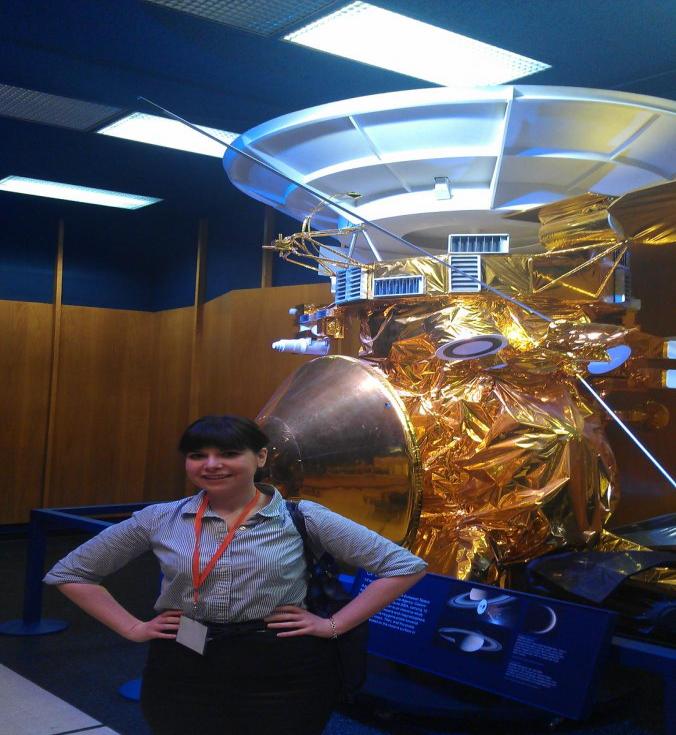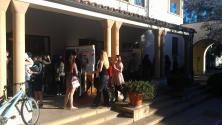Conferences for Undergraduate Women in Physics
January 18, 2013 to January 20, 2013
Pasadena, CA
Meeting host: By:Angelica Gheen
SPS Chapter:

There is something empowering about walking into a room full of strangers that you feel an instant connection with. This was my second time attending the Conference for Undergraduate Women in Physics (CUWiP), but I was instantly struck by this feeling at both. At this conference, you enter a room full of women who have the same aspirations, ambitions and uncertainties. We come from different backgrounds and have varied interests, but we’re connected. Women who choose physics have unique experiences and needs, questions and concerns that are not always easily addressed by male faculty. The goal of the CUWiP is to help bridge these gaps and help us to gain confidence and succeed in the field.
This year’s conference was held simultaneously at six different host campuses, Colorado School of Mines, Cornell University, the University of Central Florida, the University of Illinois at Urbana-Champaign, the University of Texas at Austin and the California Institute of Technology. I attended the conference hosted by the California Institute of Technology, which had scheduled a bevy of inspiring speakers at the top of their fields. We were welcomed by the president of Caltech, Jean-Lou Chameau, who encouraged us to “Never take no as a final answer” and advised, “You don’t have to win every battle…only the important ones.” But at the same time, we were made aware of our status as minorities in physics by the conference location itself. Held in the historic Feynman lecture hall, there was a severe lack of women’s restrooms; men’s rooms were re-appropriated with taped paper signs, a reminder that women were not always so welcome in this building. In her brilliant welcoming address, Nai Chang Yeh encouraged us to not let these stereotypes limit us claiming “Somehow I thought science was for boys.” Now she is at the forefront of experimental condensed matter physics.
The second day of the conference brought a question that stuck with me for the rest of the conference. “What would you attempt to do if you knew you could not fail?” This was posed by the current senior vice president of the advanced technology and projects group for Motorola Mobility, and former director of DARPA, Regina E. Dugan. Questioning the typical linear model of basic applied development, she claimed that the best work is done when, “we believe in something and then we make it so.” If someone is not questioning your sanity, she went on, then you’re not thinking big enough. I found Dr. Dugan’s enthusiasm for innovation to be infectious.
After a talk about the vast amount of graduate fellowship and research funding opportunities available from the National Science Foundation (NSF) by the acting division director for the physics division at NSF, Denise Cadwell, the keynote address was delivered via simulcast to all conference sites. The address, given by one of the leading experts on ultrafast lasers, Margaret Murnane, emphasized the importance of diversity within research teams. The more diverse a team, the more diverse it’s talents.
Following a break for lunch, the conference broke up into groups going to one of four panel discussions or lab tours, after which there was a poster session followed by another breaking off point for panels or lab tours. I opted to join the initial lab tour group, visiting the LIGO (Laser Interferometer Gravitational Wave Observatory) lab, the NuSTAR Explorer mission lab and the quantum optics lab. These tours allowed us, as burgeoning physicists, to get a peek into our potential futures. The variety of laboratory work being done was informative to many. The poster session that followed these tours illustrated the many different types of undergraduate research that was currently being done by our peers, and gave us all a chance to mingle and network with the professors and grad students in attendance.
After the poster session, I attended the Graduate School Fellowships Opportunities Panel. Other panels that were offered included a Graduate School Admissions Panel, a Graduate School Experience Panel, and an Undergraduate Research Panel. The fellowship panel was extremely helpful and answered the myriad of questions with much patience and encouragement. The benefits of obtaining fellowships were thoroughly explained as well as tips on how to make your application for a fellowship as attractive as possible.
Once our sessions ended, the attendees came together to hear undergraduate student research presentations. These presentations were well thought out and varied in their topics and applications but they all had one thing in common: they encouraged us to not allow our status as undergraduates to limit our research interests. They showed us that we are more than capable of valuable work. Dinner followed the student presentations, allowing us to make new friends and quiz those working in the field on their experiences.
The third and final day of the conference included a trip to the Jet Propulsion Laboratory (JPL) and a presentation by Rosaly Lopes, senior research scientist and acting manager for planetary science at the JPL. Dr. Lopes described her work with the Cassini mission and the future of planetary exploration with an eye towards the mission’s universal importance, not just for physics but for humanity. Even as someone with little interest in a future in astrophysics, I found myself excited about the work that was being done. After a short film on the JPL and its work, we were given free access to the JPL museum complete with fractional scale models of spacecrafts past and present.
Throughout the third day, as attendees began to head back to their universities and colleges of origin, there was a feeling of fellowship, of lifelong friendships being established in our small but mighty group. Currently, women earn about 20% of the physics bachelor’s degrees in the US and about 17% of the physics PhDs. The goal of a conference like this one is to get these numbers up, and encourage those already in the field to stay there. They remind us why completing our goals is worth the hard work and any struggles we may face. They give us a renewed sense of purpose. Returning home, I feel assured that I have chosen the correct field of study. I look forward to the future, and my role in constructing it.
Areas of Alignment: Career Resources: Scientific Categories:

